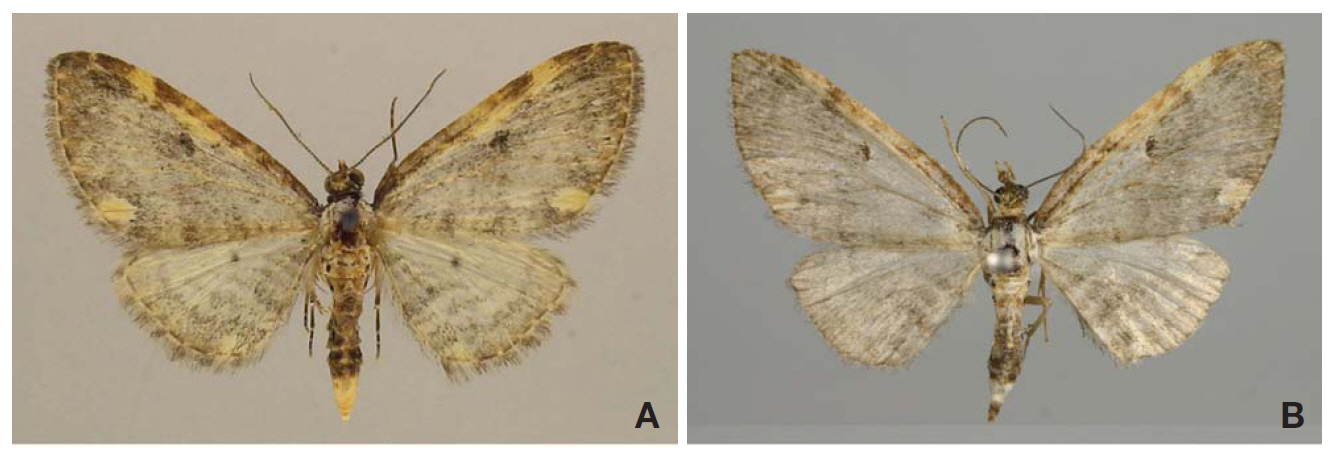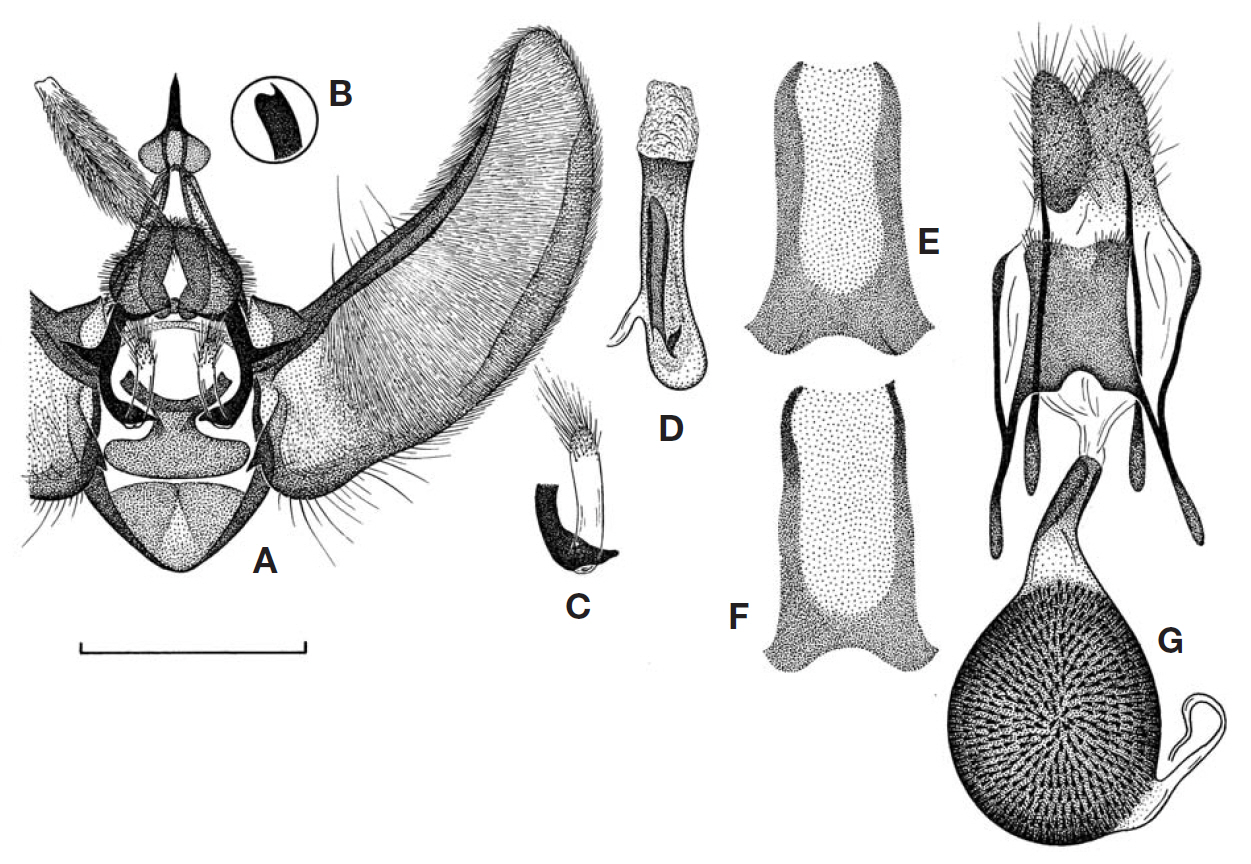



The genus
In Korea, a total of 52 species of
Examination of adults, including male and female genitalia, followed that of Scoble (1992). Abbreviations are as follows: IZBE, Institute of Zoology and Botany, Estonian University of Life Sciences, Tartu, Estonia; ZISP, Zoological Institute of Russian Academy of Sciences, Saint Petersburg, Russia; ZMMU, Zoological Museum of Moscow University, Russia; GW, Province Gangwon-do.
Order Lepidoptera Linnaeus, 1758
Family Geometridae Stephens, 1829
Subfamily Larentiinae Duponchel, 1845
Genus Eupithecia Curtis, 1825
1*
Korea: GW: 3♀, Yanggu Botanic Garden,Yanggu-gun, 21 Oct 2008, Kim SS; Russia: 1♂, S. Primorje, “Kedrovaja Pad” Nature Reserve, 8 Sep 1926, Kurentzov (ZISP); 1♂, Ussuri region, Sutchansky rudnik, 28 Sep (1)934, Palshkov (ZISP); 1♂, Primorsky kraj, Suputinsky Nature Reserve, at light, 14 Sep (19)66, Egerov (ZISP); 1♂, Prim (orsky) kraj, Sup (utinsky) Nature Reserve, spruce-pine forest, 14 Sep 1966, Kononov (IZBE); 4♂, 12♀, Primorje, “Kedrovaja Pad” Nature Reserve, 20 Sep-10 Oct 1966, Tzvetaev A (coll. Tzvetaev in ZMMU); 4♂, S. Primorje, Gornotaezhnoe, 20 km E of Ussurijsk, at light, 23 Sep 1995, Beljaev (ZISP).
This species may possibly belong to the
Wingspan 18.5-23.0 mm. Antennae filiform; frons broad, trapezoidal, mixed with dark brownish scales; labial palpi very long, almost three times of eye diameter, projected forward. Body and legs covered with whitish scales. Forewing ground colour greyish white, costa thinly covered with ochreous or yellowish scales; costal spot on the place of postmedial light transverse band large, yellow; medial area blackish, costally strongly tinged with black and projected outward, with a large blackish discal dot, one areole; subtermen pale blackish with a undulating whitish line; termen dark greyish with ochreous or yellowish large tornal spot. Hindwing ground colour paler, greyish white; pale blackish transverse lines present in basal, medial and subterminal areas; a small discal dot present but smaller and paler than on the forewing; tornal spot relatively large, yellowish.
Uncus narrow, elongated, biapical. Anal tube narrow and elongated, fusiform, densely covered with fine setae. Valva shaped like an orange segment,long and relatively narrow, with curved and almost parallel dorsal and ventral margins, evenly tapered to narrowly rounded apex; sacculus lightly sclerotized. Vinculum Vshaped, tapered anteriorly. Papillae on the anterior arms of labides narrow, elongated, covered with medium-sized setae at apices. Aedeagus slim, short and narrow, shorter than length of valve about two times. Vesica armed with one elongated and narrow longitudinally twisted plate-like cornutus, which has bifid anterior margin (one with pointed tip and other slightly broadened near apex). Sternite A8 two elongate, narrow, parallel arms, tapered and sometimes strongly sclerotized to apices, connected with each other by a short and narrow basal band; basal hollow broad and shallow; apical hollow membranous, broad and very deep.
Bursa copulatrix relatively small, ovoid, membranous, completely and densely covered with small spines. Ductus bursae short, spineless. Ductus seminalis narrow, slightly broadened at base, arising from anterior (basal) part of corpus bursae. Colliculum collar-like, narrow and elongated. Antrum short, membranous. Tergite A8 rectangular, elongated, with medial hollow in anterior margin and with membranous medial hollow and rows of dense setae in the posterior margin. Anterior and posterior apophyses long, relatively narrow, but expanded and flattened near apices; branches of anterior apophyses very long, narrow, slightly broadened at apices. Papillae anales large, broad and elongated, slightly tapered to apices, covered with elongated and medium-sized setae.
Korea, Russian Far East (southern Primorje).
This species is a univoltine species. Flying period of moths is from early September to late October. This species may possibly overwinter as an egg. Food plant is unknown.
Male genitalia of
Korean name: 1*황색점무늬애기물결자나방 (신칭)

